By Dr. Neil Canter, Contributing Editor | TLT Cover Story
December 2022
HIGHLIGHTS
• A sustainable synthetic lubricant base stock should have a high proportion of biogenic carbon; be ecofriendly; and take into consideration environmental, social and economic factors. Determination of carbon footprint through a life cycle assessment also is important. Above all, finding a definition of a sustainable synthetic lubricant base stock cannot be done without general consensus on the meaning of the term.
• Determining sustainability for a synthetic lubricant base stock can be done through a cradle-to-gate carbon footprint (CFP) process that must consider raw material sourcing, manufacturing, packaging and shipping.
• Sustainable lubricant base stocks can be used in all lubricant applications, but there are hurdles to be overcome.
• Synthetic lubricants can demonstrate sustainability in applications by demonstrating superior performance in such end-users as automotive engine oils and industrial gear oils.
As end-users of lubricants are becoming more conscious of the need to achieve sustainability, they are contacting their suppliers to ask them for documentation showing how the products they are receiving are sustainable. Among the questions to be asked are about the manufacturing process; health, safety and environmental profile; lubricant performance; and sourcing of the raw materials used.
Synthetic lubricants exhibit characteristics that can positively answer questions from end-users. For most applications, the key component that dictates how synthetic lubricants perform is the base stock. The role of additives cannot be minimized, and a previous article discusses their role in reducing the carbon footprint of lubricants.1
To learn more about the sustainability of synthetic lubricant base stocks, the following individuals were asked to provide their input:
1. Mark Miller, Biosynthetic Technologies
2. Dr. Matthias Hof, Emery Oleochemicals GmbH
3. Thilo Krapfl, Evonik Oil Additives
4. William Downey, Novvi LLC
5. Ramesh Navratnam, Patech Fine Chemicals
6. Tyler Housel, Zschimmer & Schwarz, Inc.
Definition of a sustainable synthetic lubricant base stock
STLE member Dr. Matthias Hof, global business manager bio-lubricants for Emery Oleochemicals GmbH in Dusseldorf, Germany, says, “This question will first require the definition or agreed understanding of the term ‘sustainable’ since it can mean different things to anyone using this term. In general, the term sustainable can best be described by leveraging among economic, ecologic and sociologic importance and coexistence. From this understanding, a sustainable base stock will have to be environmentally benign (non-toxic, biodegradable), economic (provide a superior cost-performance balance) and provide a positive image in our society (use renewable raw materials, have a low carbon footprint). Such a component should leverage the technical expectations achieved from increased performance capability with a cost effective and low carbon footprint package coming from a fitting chemistry and technology. Looking at the term ‘synthetic,’ Group IV and V base stocks are fitting fluids because they are prepared by synthetic manufacturing processes. Gas-to-liquid (GTL) base stocks also may be considered to match this definition.”
STLE member Tyler Housel, sales director for Zschimmer & Schwarz, Inc. in Milledgeville, Ga., states that a product with a high proportion of biogenic carbon and not fossil carbon can usually be considered sustainable. He says, “Vegetable oils and synthetic esters have a high proportion of renewable biogenic carbon and will decompose into carbon dioxide that can repeat the cycle. Petroleum oils and many synthetic hydrocarbons are derived from fossil carbon and contribute to an increase in atmospheric carbon dioxide.”
STLE member Ramesh Navratnam, business manager, Patech Fine Chemicals in Dublin, Ohio, says, “Currently, the definition is based on ecofriendly and renewable base stocks. Generally speaking, in terms of esters, a significant percentage of the acid and alcohol portions are derived from vegetable sources. However, this definition is shifting to include not only vegetable-based raw materials but also those derived from non-food oils or from a biomass source.”
STLE member William Downey Jr., senior vice president, business development for Novvi LLC in Alameda, Calif., feels that the first step in defining a sustainable synthetic lubricant base stock is to determine its carbon footprint through a life cycle assessment (LCA). He says, “Our working definition of a sustainable product is one that has a carbon negative cradle-to-gate carbon footprint (CFP), which also improves the efficiency of the in-use application. The only way to achieve a carbon negative, cradle-to-gate CFP is to use a process that pulls carbon dioxide out of the air to manufacture a component—a process which is accomplished by plant-based feedstocks through photosynthesis.”
Thilo Krapfl, vice president industrial, Evonik Oil Additives in Darmstadt, Germany, says, “In general, a lubricant base stock must be sustainable in the environmental (planet), social (people) and economic (profit) dimension. In the environmental dimension, specifically, it is important to consider the entire life cycle including production, use and end of life of the lubricant. As these absolute values can be difficult to assess, comparisons with current existing technologies offer guidance.”
STLE member Mark Miller, CEO of Biosynthetic Technologies in Indianapolis, Ind., indicates that there is no standard answer for the definition of a sustainable synthetic lubricant base stock. He says, “The United Nations (UN) defines sustainable as ‘development that meets the needs of the present without compromising the ability of future generations to meet their own needs.’ A sustainable substance can be viewed as derived from a natural resource. Two other factors to consider are environmental fate (if the substance escapes into the environment) and biodegradability. To complete the definition, the synthetic term means that a substance must be modified from its original form to impart enhanced performance.”
Determination of sustainability
Downey says, “Conducting an LCA to determine a cradle-to-gate CFP for a specific base stock is the first step in understanding the sustainability story of a base stock. A cradle-to-gate CFP is defined as the total greenhouse gas emissions generated by producing a substance, from its extraction of raw materials, transportation, emissions from manufacturing and packaging. The CFP value is expressed as kilograms of carbon dioxide equivalent per kilogram of the base stock.”
Downey continues, “Table 1 provides a high-level ballpark comparison of five base stocks’ cradle-to-gate CFP. A positive figure is an indication that the base stock produces more carbon dioxide than it removes during its manufacture. A negative figure is the opposite where a base stock removes more carbon dioxide than it produces.”
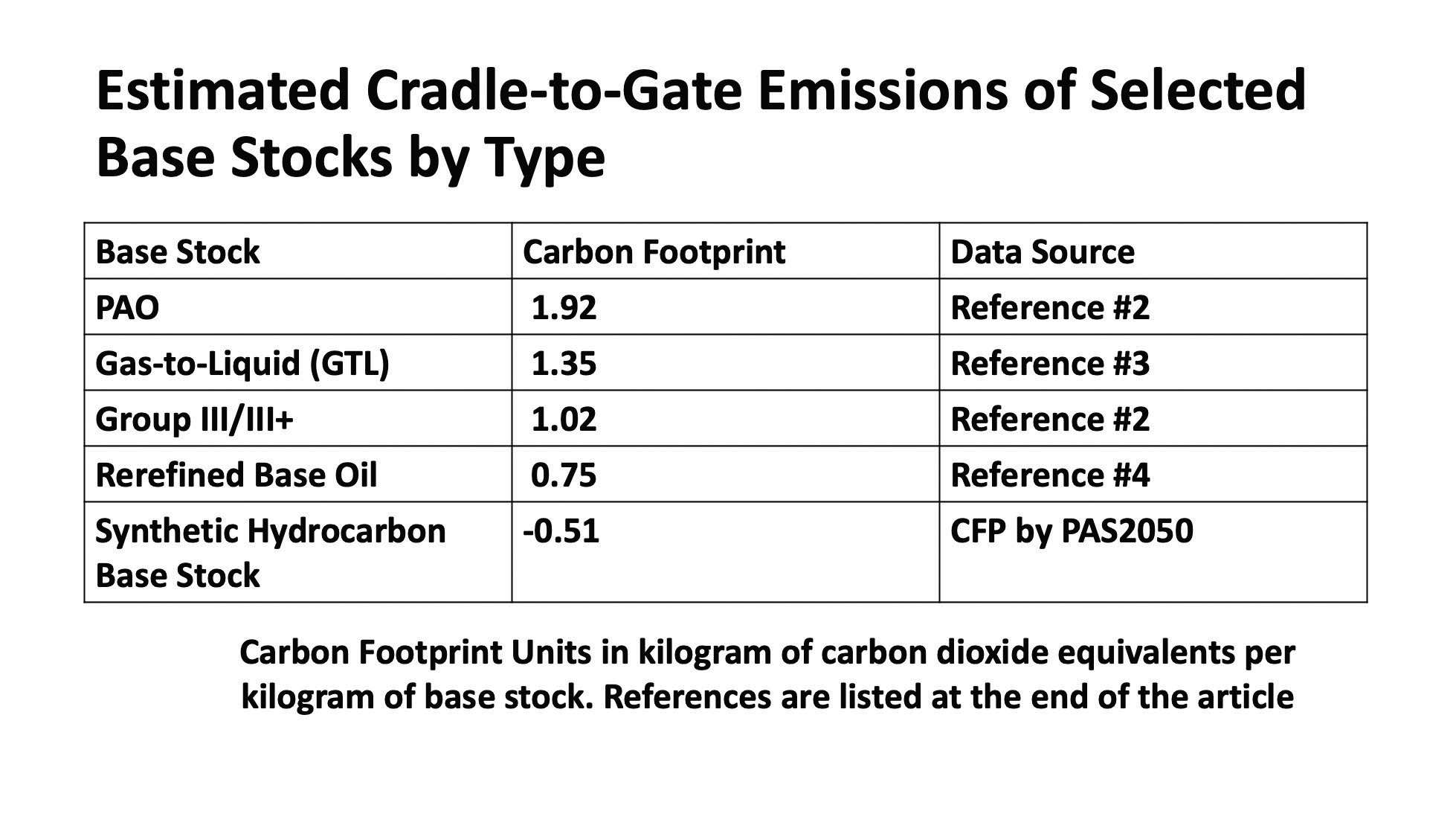
Table 1. The carbon footprint for cradle-to-gate emissions of five base stocks is shown. A positive value is an indication that the base stock produces more carbon dioxide than it removes during raw material sourcing, transportation, manufacturing and packaging. For a base stock with a negative value, more carbon dioxide is removed during manufacturing than produced. Table courtesy of Novvi LLC.
Downey points out that the values for each base stock type are arrived at by different methods and assumptions.2-4 For the GTL reference, the value used is from the GTL diesel process in which the GTL base stock is a byproduct of and should have a similar LCA value for this analysis. The value for GTL is in grams of carbon dioxide equivalent per millijoule. To convert this figure to kilograms of carbon dioxide equivalents per kilogram of base stock, the 2018 GREET (Greenhouse Gases, Regulated Emissions and Energy Use in Technologies) model was used.3
The source for the CFP for the synthetic hydrocarbon base stock follows the guidelines of the British Standards Institute (BSI) that developed and revised in 2011 a specification for the assessment of the life cycle greenhouse gas emissions of goods and services known as PAS 2050.5
Miller points out that carbon footprint (as defined by LCA) is only one factor to consider in determining the sustainability of a synthetic lubricant base stock. He says, “There are additional factors that should be included besides LCA. Included should be social sustainability (does it support people) and economical sustainability. A proper LCA is essential in determining at least part of sustainability.”
Krapfl believes that any sustainability claim must be substantiated with solid data and fact based arguments. He says, “Life cycle thinking is crucial for this and, hence, also LCA. However, LCAs rely on a vast amount of data, mostly coming from databases. Therefore, it is important that more organizations use primary data to calculate LCAs, which then, in turn, translate into better transparency about the environmental performance of raw materials. For social sustainability, supply chain is a very important issue, and transparency is vital.”
Housel feels that a traditional definition of sustainability is “meeting our own needs without compromising the ability of future generations to meet their own needs.” He says, “A variety of independent organizations and techniques are available to certify various aspects of sustainability. For example, the USDA BioPreferred Program® established ASTM D6866 to determine the amount of biogenic carbon in a sample. This method measures the carbon-14 content in a sample, enabling the calculation of the amount of carbon derived from current biogenic sources.”
Housel continues, “Raw material sourcing and manufacturing of a specific synthetic lubricant base stock are important elements contributing to the total sustainability rating. The total amount of energy required to manufacture, package and ship the material also must be considered if the energy source is fossil carbon. Using renewable energy sources (wind, solar or hydropower) at this stage of a base stock’s life cycle can improve its sustainability rating. Some synthetic esters use raw materials derived from palm oil. The Roundtable on Sustainable Palm Oil (RSPO) organization has established a set of environmental and social criteria that manufacturers of this vegetable oil must comply with in order to produce Certified Sustainable Palm Oil (CSPO). RSPO-certified products ensure that the feedstocks are not just biobased but meet other environmental, social and governance (ESG) requirements for a sustainably produced raw material.”
Another organization, International Sustainability and Carbon Certification (ISCC), is a global sustainability certification system that covers all sustainable feedstocks, including agricultural and forestry biomass, biogenic wastes and residues, circular materials and renewables. The ISCC is committed to a no-deforestation standard and strives to protect forests, high-carbon stock lands and biodiversity.”
Housel states the case for why lubricants provide a strong contribution to improving the sustainability of industrial processes. He says, “Products from the lubricant industry clearly contribute to energy efficiency and carbon dioxide reduction as they reduce friction and wear. This results in less fuel consumption and extension of equipment life. As an example, synthetic lubricants derived from esters with naturally high viscosity indices reduce fuel consumption when used in energy efficient hydraulic fluids, thereby reducing carbon dioxide generation and extending pump life.”
Housel feels there is significant potential for synthetic lubricant base stocks to reduce the considerable amount of energy produced annually to overcome friction. He says, “Holmberg and Erdemir report6 that approximately one-fifth of all energy produced globally on an annual basis is needed to overcome friction. This results in the loss of 100 terajoules of energy, the creation of heat and generation of over one billion metric tons of carbon dioxide annually. The opportunity now exists for improvements in tribology and lubrication science to reduce this large number.”
Hof states that LCAs are a good tool to determine the contribution a product, chemical or component can offer to the overall carbon footprint. But comparing results is very challenging because there are many different methodologies. He says, “There are several computer tools available, but even more important are the input data for raw materials, which represents the biggest hurdle to generating comparable data. The German Lubricant Manufacturers Association (VSI) has established a task force looking at this topic.”
Hof provides a list of criteria to use to evaluate the sustainability of a specific synthetic lubricant base stock.
• What is the chemistry?
• Is the substance non-toxic?
• What raw materials (renewable and non-renewable) are used for production?
• Is it biodegradable and to what extent (readily or not)?
• Does it meet the necessary requirements such as performance, treat rate and availability?
Hof says, “Answering these questions is very important in gaining a better understanding about a synthetic lubricant base stock’s sustainability. But a general and consistently agreed understanding of when to define a lubricant base stock as sustainable is not currently available.”
Navratnam says, “LCA is an important tool to use in determining sustainability. Further improvement of the LCA is made through raw material selection and process improvements.”
Lubricant applications
Housel says, “Any application that consumes high amounts of energy derived from fossil fuel or does energy-intensive manufacturing will benefit from sustainable lubricants. Examples includes aviation turbine engines, refrigeration and gas compression, hydraulics and engine and driveline general mobility applications. Synthetic esters have demonstrated the ability to improve efficiency, reduce energy consumption and extend equipment life in these applications while using a sustainable base fluid.”
The growing use of electric vehicles is opening up opportunities for synthetic lubricant base stocks. Housel continues, “Synthetic esters with high biogenic content are emerging as a good choice for dielectric fluids used in multifunctional lubricant/immersion coolants. They offer a superior combination of high dielectric strength, heat transfer and fire resistance properties compared to mineral oil base stocks.”
Hof indicates that sustainable synthetic base stocks have the potential to be used in all lubricant applications but acknowledges that there are hurdles to such a broad adoption. He says, “Cost comes to mind for lubricant manufactures and end-users in considering working with a synthetic lubricant base stock. For example, in general, esters are estimated to be at least double the cost compared to Group III and PAO base stocks.”
Hof continues, “With sustainability becoming more important to end-users, base stocks such as esters are needed and, at times, legally required for use in applications where biodegradability is important particularly for legal requirements. This factor has facilitated the growing use of synthetic lubricants. To complement this trend, more end-users are changing their marketing strategy and updating company culture to acknowledge the need for sustainability. They are asking lubricant manufacturers to follow through with products that meet their requirements. Such products must be prepared from synthetic lubricant base stocks.”
Krapfl believes that sustainable base stocks are required for all applications for a more sustainable world. He says, “Synthetic base stocks are better able to handle industrial applications such as shock loads, mining machinery, extreme loads and wind turbines, which all demand high reliability of operation. Many of these applications need to withstand harsh operating conditions and are more likely to require synthetic base stocks that demonstrate superior performance. Mineral oil base stocks have one-third of the service time of synthetic base stocks. Adopting sustainable synthetic lubricant base stocks is necessary to achieve these sustainability targets as well as to improve operational efficiency.”
Navratnam claims that the need for sustainable synthetic lubricant base stocks is growing due to their use in applications such as marine, agriculture and forestry where accidental spillage into the environment is a possibility. He says, “Original equipment manufacturers (OEMs) in other sectors, including automotive, recreational watercraft and refrigeration, have made sustainability a requirement. Many of these companies are publicly owned and market well-known brands. As a result, they must be in compliance with regulatory sustainability requirements dictated by governments in their locales.”
Miller says, “Any application that operates large equipment in an environmentally sensitive area should have the need for a sustainable synthetic lubricant base stock. With current resources declining in availability, end-users are seeking to work with increasing quantities of sustainable lubricants to ensure reliable supply over the long term.”
Downey says, “There is a great need for sustainable lubricants to provide energy savings during use. To achieve sustainability, the lubricant must be at least carbon neutral with the desired goal being carbon negative. However, a negative cradle-to-gate CFP is just the first part of a sustainable lubricant. The product also should reduce the CFP of the in-use application. One important example is automotive engine oils where a synthetic sustainable lubricant base stock can increase fuel economy leading to less fuel consumption and, as a consequence, lower emissions.”
Examples
Two factors that a sustainable synthetic lubricant base stock must accomplish are long oil drain intervals and improved energy efficiency, according to Krapfl. He says, “An alkylmethacrylate oligomer meets these requirements after undergoing extensive testing in industrial gear oils used in applications such as mining. One example is the 2.9% energy savings realized in testing conducted at a water treatment plant compared to a mineral oil-based product exhibiting the same viscosity. Superior lubricity leading to reduced friction probably accounted for this energy savings.”
Hof says, “Esters are the synthetic lubricant base stock with the best set of economic, ecologic and sociologic properties to meet sustainability as measured by the biodegradable, aquatic toxicity and renewability criteria required for listing on the European Ecolabel LuSC list. Low viscosity polyalphaolefins (PAOs) and polyalkylene glycols (PAGs) also are suitable candidates and also are now included on the LuSC list.”
Miller says, “In assessing the potential for a synthetic lubricant base stock to be sustainable, such factors as useful life, friction reduction, energy efficiency and environmental fate must all be taken into consideration. A class of esters known as estolides derived from renewable sources, other bioderived esters and bioderived PAGs are examples of sustainable synthetic lubricant base stocks.”
While composition and performance are two requirements that must be considered in presenting examples of sustainable synthetic lubricant base stocks, Navratnam feels that selection of raw materials and process parameters used in manufacturing must be evaluated. He says, “To offset the higher cost of sustainable synthetic lubricant base stocks, factors such as lubricity and high temperature stability must be demonstrated to justify their use to lubricant manufacturers and end-users. Deriving raw materials from vegetable non-food sources is important to show that sustainable sources are used in the manufacturing process that do not impact edible products. Esters can exhibit these characteristics making them good candidates for synthetic lubricant base stocks. Base stock manufactures need to supplement this by focusing on continuously improving their manufacturing practices through energy reduction and efforts to recycle waste water. Both potentially lead to improved productivity.”
Housel asserts that synthetic esters are prime examples of sustainable synthetic lubricant base stocks. He says, “Esters have a long history of exceptional performance, and many environmental credentials such as the USDA BioPreferred Program and EU Ecolabel and a variety of ISO, DIN and other standards that define environmentally acceptable lubricants. Several also are appropriate for food processing applications, being registered as HX-1 by NSF, kosher and halal.”
Housel also notes that polyol esters can be manufactured from raw materials that are biogenic. He says, “Polyol esters are prepared from fatty acids and (neo) polyols with two or more hydroxyl groups. RSPO palm oil and other vegetable oils are a common source of biogenic fatty acids. Common polyols such as neopentyl glycol, trimethylolpropane and pentaerythritol also are available from biogenic raw materials.”
Comparison with mineral oil base stocks
One example of improved performance is a passenger car engine oil (PCMO) formulated with a synthetic hydrocarbon base stock that exceeds the passing requirement for the Sequence IIIH Engine Test. The purpose of this test is to evaluate the high temperature properties of an engine oil for an increase in viscosity and piston deposit formation. Sequence IIIH uses a fuel-injected gasoline engine and is run at 137 brake horsepower, 3,900 rpm and with a lubricant temperature of 151 C for 90 hours.
As shown in Figure 1, results for a 0W-20 PCMO are measured as percent viscosity increase and weighted piston deposit merits. The left bar chart in Figure 1 shows that the viscosity increase of the synthetic hydrocarbon base stock is very small (0.1% increase) relative to the 100% increase, which is the maximum passing value.
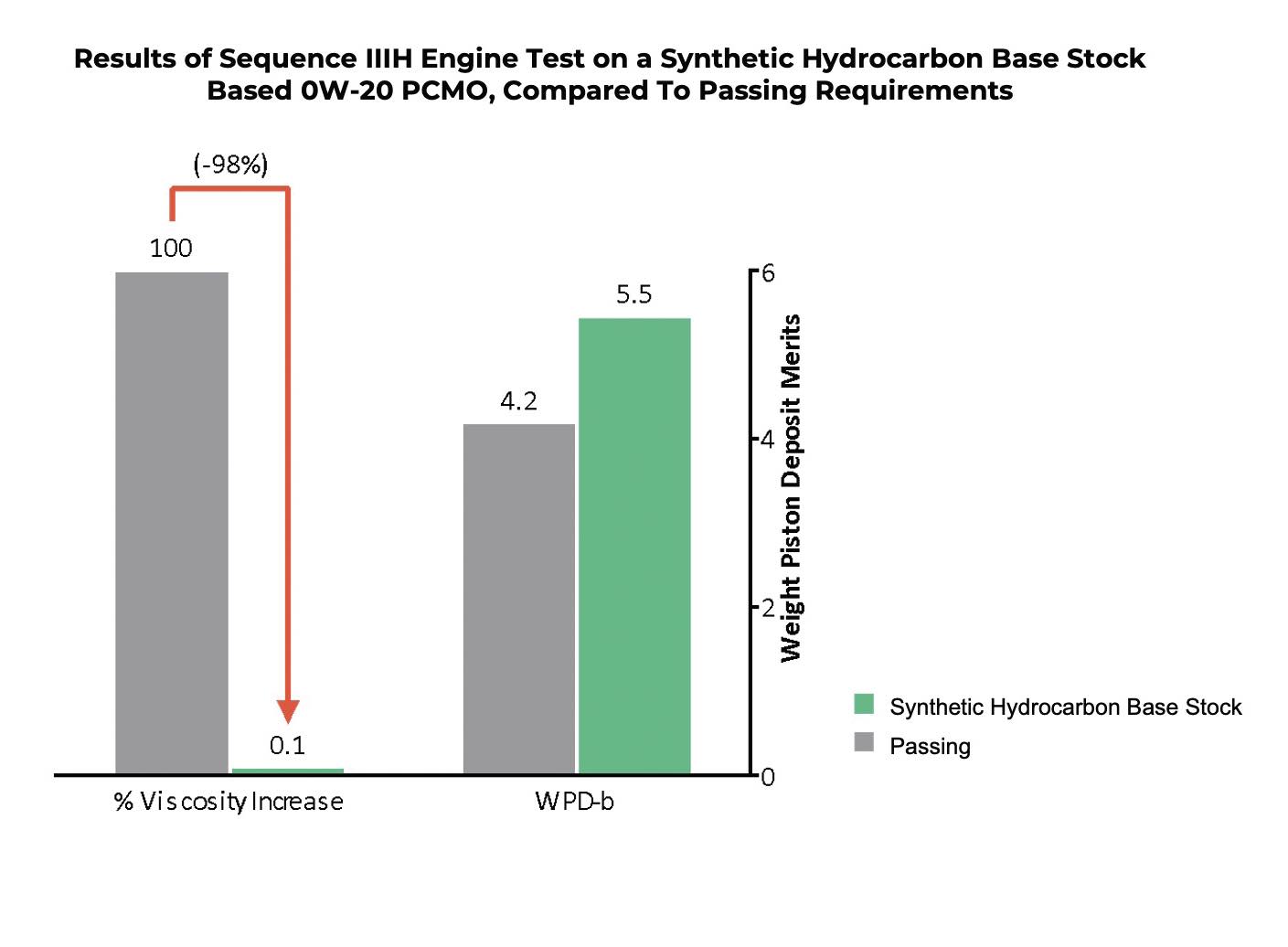
Figure 1. Sequence IIIH results conducted with a 0W-20 passenger car engine oil based on a synthetic hydrocarbon base stock exceed the passing requirement for the test. Figure courtesy of Novvi LLC.
The weighted piston deposit is measured on a merit system where a higher value means lower deposits. The 0W-20 PCMO derived from the synthetic hydrocarbon base stock achieves a merit rating of 5.5, which is clearly above the minimum passing value of 4.2.
Additional data supporting the performance of the synthetic hydrocarbon base stock was developed by using the mini-traction machine (MTM) that measures coefficient of friction over a wide range of temperatures and slide-to-roll ratios (SRR). Figure 2 shows an illustration of coefficient of friction versus SRR under a load of 20 newtons at temperatures of 40, 60 and 80 C (from left to right). The synthetic hydrocarbon base stock was evaluated along with a low traction version versus GTL, Group III and PAO, all at a viscosity of 4.5 cSt at 100 C.

Figure 2. Three graphs of coefficient of friction versus slide-to-roll ratio (SRR) show results from a mini-traction machine study run under a load of 20 newtons at three temperatures (40, 60 and 80 C). A low traction version of the synthetic hydrocarbon base stock displayed superior performance compared to gas-to-liquid, Group III and PAO base stocks. Figure courtesy of Novvi LLC.
Downey says, “The low traction version of the synthetic hydrocarbon base stock exhibits lower coefficient of friction values over the range of SRRs for each temperature measured than the other base stocks.”
The increasingly demanding operating conditions for lubricants means that low volatility is important to ensure optimum performance over a long operating period. Noack volatility measures weight loss of a lubricant when held at 250 C for one hour. Figure 3 shows data collected on five types of synthetic base stocks (estolides, polyol ester, diester, PAO and PAG) and three types of mineral oil base stocks (Group I, II and III) following ASTM D5800.
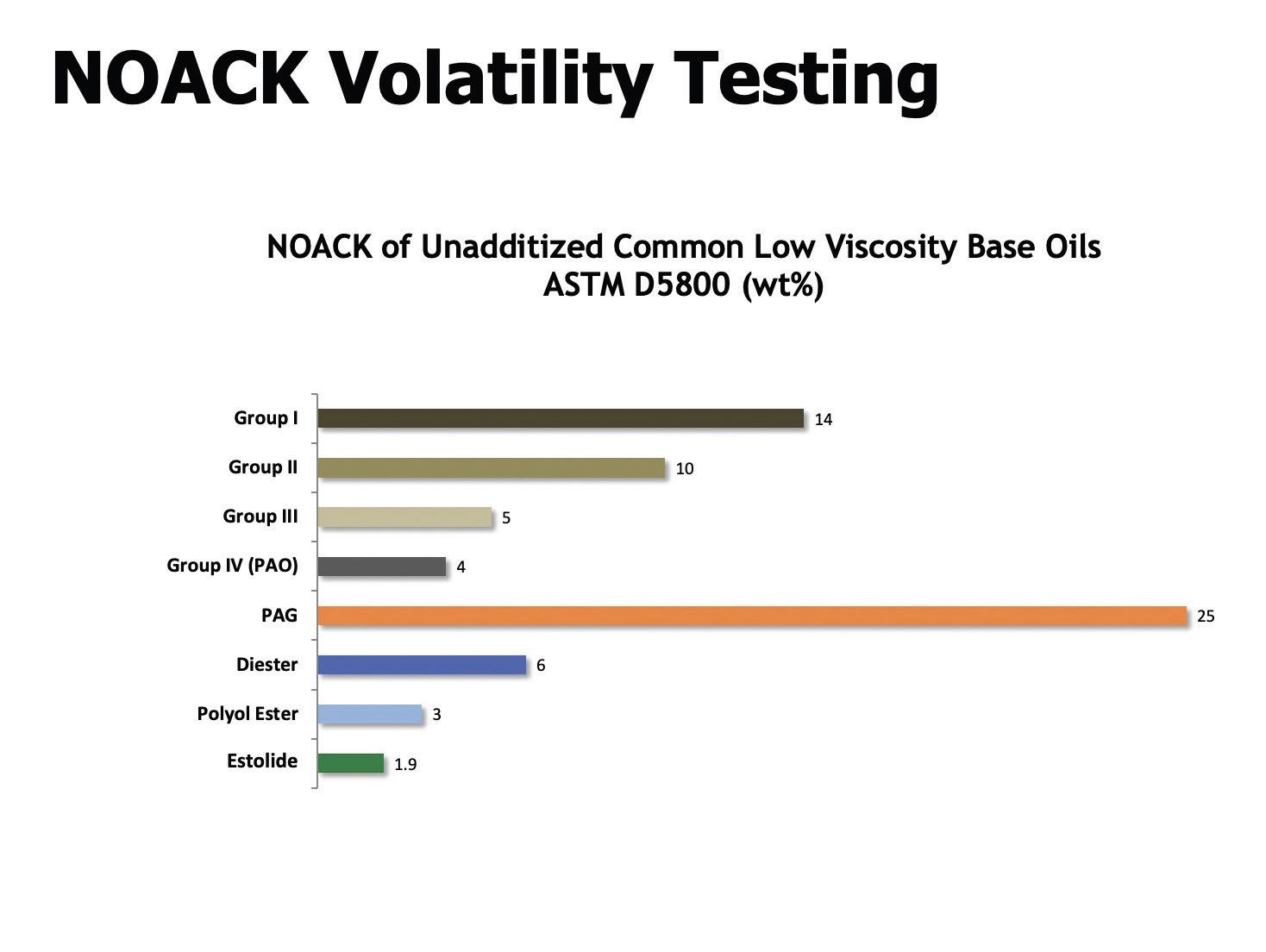
Figure 3. Noack volatility data on five synthetic base stocks is shown and compared to Group I, II and III mineral oil base stocks. A lower value is important in maximizing lubricant performance over a long operating period. An estolide showed the lowest value of all base stocks tested in this study. Figure courtesy of Biosynthetic Technologies.
Miller says, “Estolides, a type of ester, displayed superior volatility with a weight loss of only 1.9% compared to the other seven base stocks.”
Navratnam says, “In contrast to mineral oil base stocks, esters are engineered molecules that can be synthesized to deliver lubricity, oxidation stability, elastomer compatibility and other important performance parameters.”
Hydrolysis is a vulnerability for synthetic ester base stocks. ASTM D2619 is a standard test for evaluating this parameter. Figure 4 shows samples of high viscosity synthetic and mineral oil base stocks that are evaluated using a modified version of the ASTM procedure. Typically, samples are placed in a capped bottle with water and a copper strip that acts as a catalyst. The mixture is heated at 93 C for 48 hours.
Miller says, “In Figure 4, five base stocks (three synthetic and two mineral oil based) were evaluated for hydrolytic stability for 144 hours, which is three times longer than the standard ASTM procedure. Hydrolysis is measured by changes in the acid number of the base stocks during the test. The estolide demonstrated good hydrolytic stability by only showing a slightly higher acid number than the two synthetic hydrocarbon and two mineral oil base stocks. Viscosity change for the estolide was comparable with four of the base stocks and much lower than for the naphthenic bright stock.”
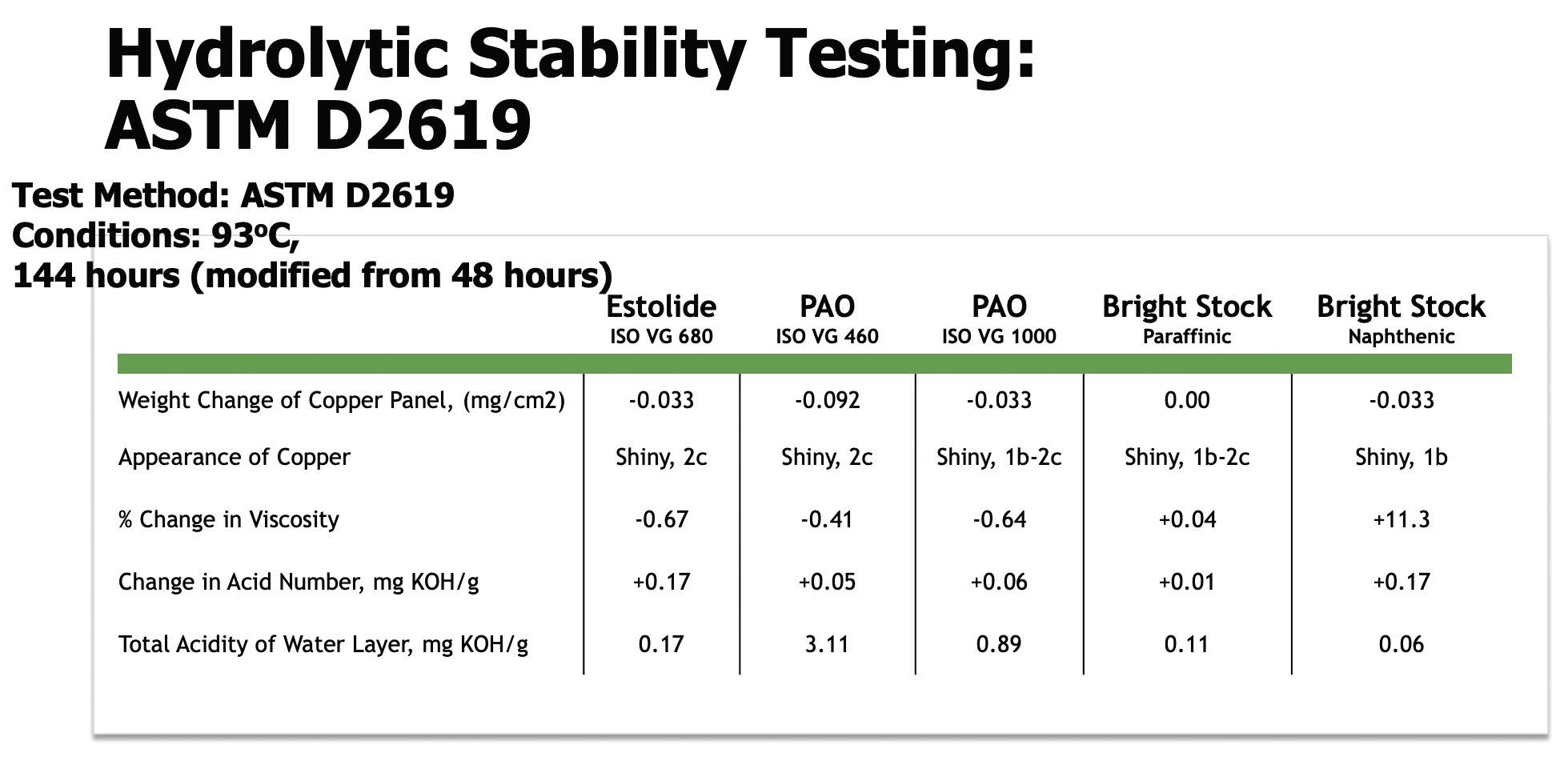
Figure 4. The ASTM D2619 hydrolysis test was conducted on three synthetic and two mineral oil base stocks for a period (144 hours) three times longer than the standard procedure. An ester-based estolide showed good hydrolytic stability compared to the two synthetic hydrocarbon and two mineral oil base stocks. Figure courtesy of Biosynthetic Technologies.
Miller continues, “Reaction with the copper catalyst was slightly worse as measured by the change in copper weight of the copper strip and the appearance rating. But the estolide showed good stability over the extended test duration when exposed to a hydrolysis catalyst at elevated temperature.”
Krapfl discusses the results from an industrial gear oil study involving lubricants based on the alkylmethacrylate oligomer and mineral oil base stocks. The study was conducted on a bevel-spur gearbox at a mining site. He says, “Significantly lower operating temperatures (from 6 C to 13 C) were observed with the alkylmethacrylate oligomer compared to the gear oil formulated with a mineral oil base stock. In Figure 5, a 13 C reduction in operating temperature was achieved with the alkylmethacrylate oligomer after seven hours under a 30% load.”
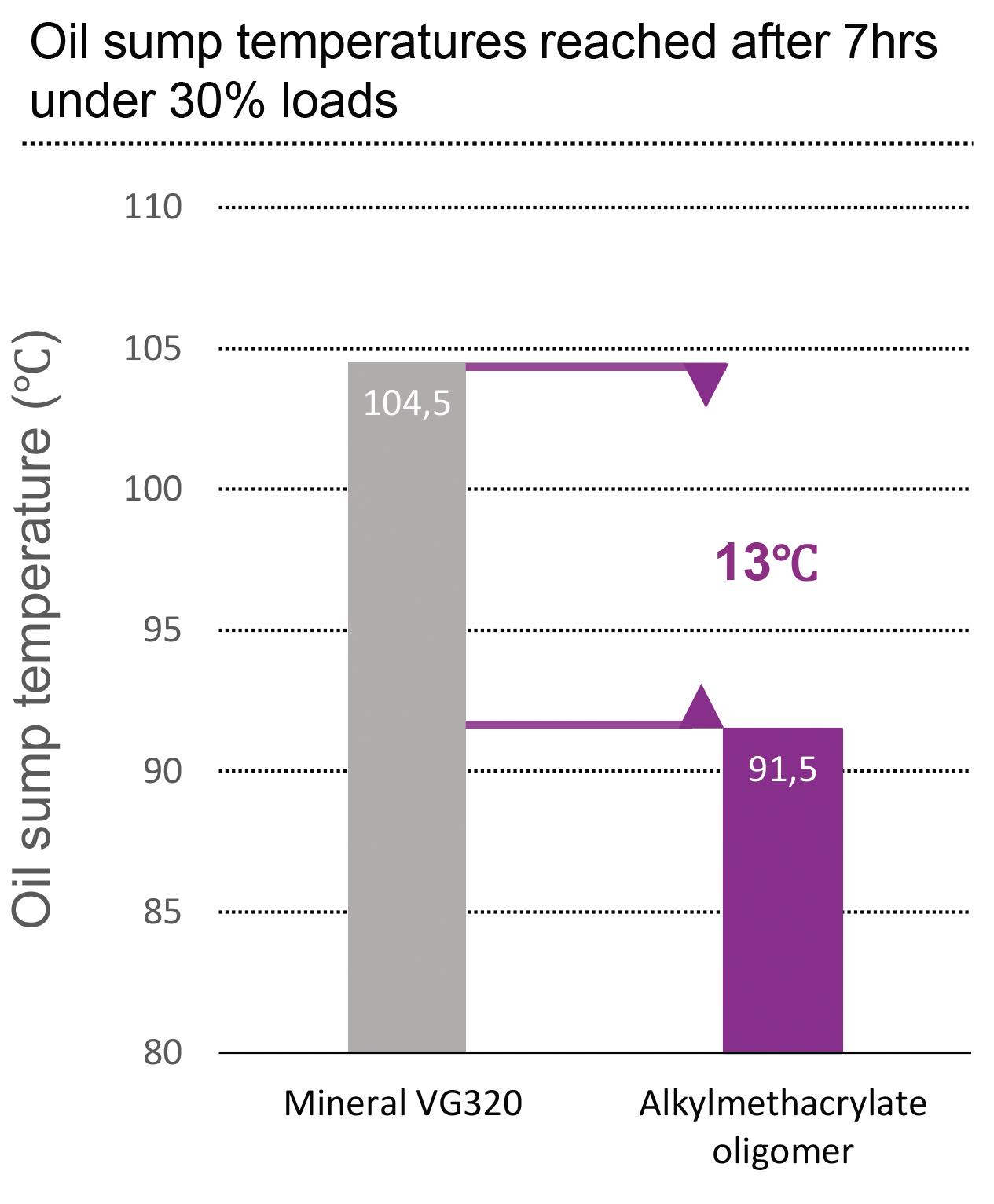
Figure 5. An industrial gear oil based on an alkylmethacrylate oligomer demonstrated a significant reduction in temperature (13 C) when compared to a mineral oil-based lubricant after seven hours of testing at a 30% load in a bevel-spur gearbox. Figure courtesy of Evonik.
Krapfl continues, “Reducing operating temperatures of gear oils by 10 C has been found to reduce the oxidation rate by approximately 50% leading to at least a doubling of the oil drain interval. This performance demonstrates that the alkylmethacrylate oligomer can act in a sustainable manner by increasing productivity and reducing downtime.”
Housel highlights additional properties that make esters more suitable than mineral oil base stocks for use in high performance applications. He says, “Esters offer higher polarity for improved additive solubility and lower deposit formation leading to extended drain intervals. Polarity also results in adsorption to the metal surfaces enhancing lubricity and corrosion protection. These performance features are complemented by more beneficial health and safety properties that ensure an end-user is less concerned about potential leakage or accidental loss because esters can be selected that are readily biodegradable. The oxygen content of an ester compared to a hydrocarbon-based oil results in lower heats of combustion, allowing esters to be ‘less hazardous’ if exposed to sparks, molten metal, open flames or ammunition/explosives.”
The superior performance characteristics of esters are illustrated in Figure 6, which shows the lifetime of air compressor oils formulated with three synthetic base stocks (polyol ester, diester and Group IV) and a Group II base stock. The polyol ester exhibits a lifetime of 8,000 hours at 220 F (105 C) versus a Group II base stock, which is functional for only a brief period of time.
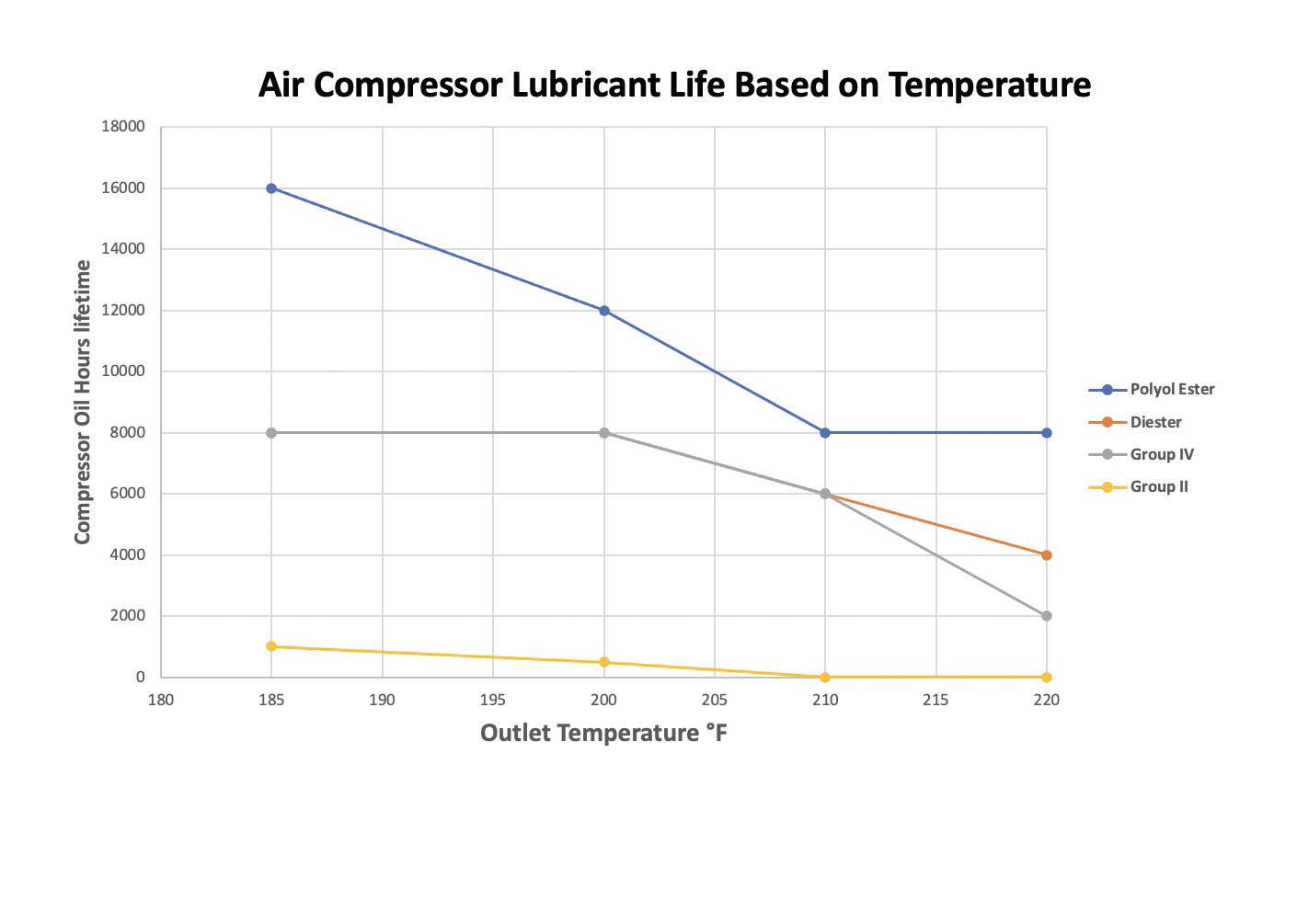
Figure 6. The operating life of air compressor oils derived from three synthetic base stocks and one mineral oil base stock is shown. A lubricant based on a polyol ester displayed a lifetime of 8,000 hours at 220 F (105 C) compared to a Group II base stock-based compressor oil that functioned for only a brief period of time. Figure courtesy of Zschimmer & Schwarz, Inc.
Hof considers mineral oil base stocks to not exhibit the necessary biodegradability to be sustainable. He adds, “In contrast, esters, particularly those derived from oleochemical or renewable sources, are a much better fit due to displaying better operating performance and sustain-ability characteristics.”
Sustainability versus environmentally friendly or biobased
Navratnam states that not all synthetic lubricant base stocks that display environmentally friendly and biobased characteristics meet the ESG characteristics required for sustainability. He says, “Clearly, a more stringent guideline is required. As an example, vegetable sources that use forced labor in processing raw materials for use in synthetic lubricants are not sustainable, even though they meet all of the environmental requirements for sustainability.”
Krapfl states that holistic life cycle thinking is needed to consider the application where the lubricant base stock is used in order to determine if an environmentally friendly or biobased lubricant is sustainable. He says, “For example, pure rapeseed oil is biobased, biodegradable and might be environmentally friendly. But use of this vegetable oil in a lubricant produces little positive effect on how the lubricant performs in a specific application meaning that no sustainable benefit can be realized through such factors as improved productivity or reduced energy usage.”
Housel takes a different approach by focusing on the possibility of recycling biogenic carbon used in synthetic lubricant base stocks. He says, “Sustainability, environmentally friendly and biobased characteristics all offer some advantage to the environment, but combining all of them offers the greatest advantage. In general, biogenic carbon that cycles from the air (as carbon dioxide) to biomass via photosynthesis and is then converted to a synthetic lubricant can, after use, end up back in the air through biodegradation. This leads to a more sustainable option as the carbon can be indefinitely regenerated.”
Hof believes that sufficient definitions are in place for biobased and environmentally friendly but are not agreed upon for sustainability. This results in difficulty in reconciling the terms. He says, “The C14 data generated according to ASTM D6866 can clearly show if a synthetic lubricant base stock is biobased. This test method is used as the basis for the USDA BioPreferred Program, which certifies products by percentage of biobased content. Environmentally friendly is defined by various standards such as the EcoLabel and the Swedish Standard. Both are used in the Vessel General Permit (VGP) regulation to define environmentally acceptable lubricants. But no process is currently available to link these definitions to sustainability.”
Miller says, “Sustainable synthetic lubricant base stocks are typically environmentally friendly because this refers to their environmental fate, i.e., what happens if it leaks into the environment and involves an understanding of factors such as biodegradability, ecotoxicity and bioaccumulation. They also are biobased because they originate with raw materials derived from renewable sources.”
Downey says, “There is a difference among the terms sustainability, environmentally friendly and biobased, and it is important to understand the nuances. A synthetic lubricant base stock can be confirmed as biobased after being evaluated by ASTM D6866. However, biogenic carbon does not ensure the product is sustainable, environmentally friendly or that it should have negative cradle-to-gate CFP. All metrics from feedstock production must be considered during the LCA and CFP process. Whether a base stock is environmentally friendly can be found through the use of bioaccumulation testing and additional environmental factors studied in the LCA.”
The future
Hof believes that the drive to more sustainable base stocks in lubricant formulations is just getting started. He says, “Currently, most lubricant formulators are asking their suppliers for input and contribution to reach sustainability targets and goals. Growing demand in our industry will facilitate the transition of sustainability from being a request to becoming a requirement. At present, having sustainability data available to provide to lubricant formulators and end-users is nice. But in the near future, base stock suppliers will be challenged to provide documented data identifying the sustainability and carbon footprint of their products. Without this data, it will become challenging to support and develop future business.”
Krapfl indicates that sustainability will be important in every lubricant application, and the performance advantages of synthetic lubricant base stocks will reduce the total cost of ownership. He says, “Synthetic base stocks provide longer oil drain intervals, improving the productivity of end-user machinery, and lower operating temperatures, which leads to higher energy efficiency and better equipment protection. Large equipment operating in highly demanding environments will therefore initially be the best fit for sustainable synthetic lubricant base stocks.”
Housel states that the movement to biogenic transformer fluids and electric vehicle lubricants/coolants will hit a critical point in the next decade. He says, “By 2035, it is likely that most vehicles will have 20 liters of a sustainable electric vehicle lubricant/coolant instead of five liters of a fossil based internal combustion engine (ICE) engine oil.”
Miller says, “There is a growing need and interest in sustainable synthetic lubricant base stocks. They are especially needed in situations where heavy equipment works in environmentally sensitive areas. As a result, more end-users will be using synthetic lubricant base stocks as they strive to be more sustainable.”
Downey initially sees that the emphasis for sustainability will involve the development of top-tier lubricants in both the automotive and industrial segments. He adds, “These lubricants formulated with sustainable and environmentally friendly synthetic base stocks will see growth in biobased hydraulic fluids used near water sources, forestry, mining and off-highway applications.”
Navratnam discusses the prospect of the lubricant industry preparing blends of sustainable with non-sustainable base stocks as a means to meet the current and near future demand for sustainable lubricants. He says, “The industry as a whole is growing even though there is a significant cost difference among base stocks. However, it is worth noting that the volume of sustainable lubricant base stocks produced today and in the near future will not meet industry demand. Formulators will need to rely on blends, such as esters with PAOs, from now through the near future. This will furnish sufficient time for supply of sustainable synthetic lubricant base stocks to increase. An added benefit is pricing should decline further accelerating growth.”
Synthetic lubricant base stocks have always demonstrated excellent performance characteristics that exceed those of mineral oil base stocks in most applications. The onset of and growing desire for sustainability is increasing interest in their use. This trend has started now and shows no sign of diminishing into the future.
REFERENCES
1. Canter, N. (2022), “Sustainable additives: Assisting with reducing the carbon footprint of lubricants,” TLT, 77 (9), pp. 14-27. Available here.
2. Girotti, G., Raimondi, A., Biengini, G. and Fino, D. (2011), “The contribution of lube additives to the life cycle impacts of fully formulated petroleum-based lubricants,” American Journal of Applied Sciences, 8 (11), pp. 1232-1240.
3. Forman, G., Hahn, T. and Jensen, S. (2011), “Greenhouse gas emission evaluation of the GTL pathway, “Environmental Science & Technology,” 45 (20), pp. 9084-9092.
4. Fehrenbach, H. (2005), “Ecological and energetic assessment of re-refining used oils to base oils: Substitution of primarily produced base oils including semi-synthetic and synthetic compounds,” Institut für Energieund Umweltforschung GmbH (IFEU), a study commissioned by GEIR-Groupement Européen de l’Industrie de la Régénération.
5. Click here.
6. Holmberg, K. and Erdemir, A. (2017), “Influence of tribology on global energy consumption, costs and emissions,” Friction, 5 (3), pp. 263-284.
Neil Canter heads his own consulting company, Chemical Solutions, in Willow Grove, Pa. You can reach him at neilcanter@comcast.net.